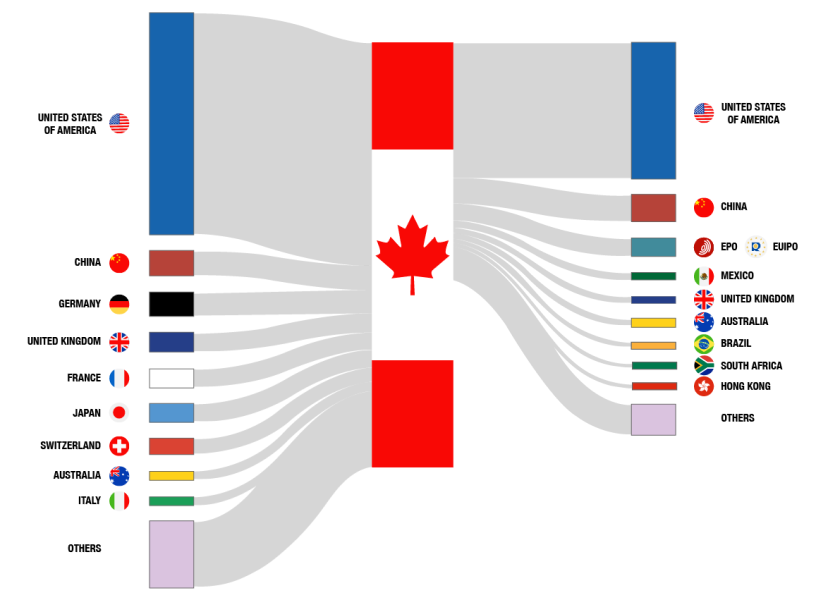Canada is a major international destination and source of IP rights, with almost 160,000 applications each year for patents, trademarks, and industrial designs coming to CIPO from applicants around the world, and originating from Canadian residents and filed in other jurisdictions. The IP Canada Report presents trends and research in IP use both in Canada and by Canadians globally using data from CIPO and WIPO.

Figure 1 - Text version
Figure 1 is a Sankey diagram that maps the flow of IP applications into Canada by origin and out of Canada by destination. The centre of the diagram shows the Canadian flag, with IP applications to Canada on the left side and IP applications from Canada on the right side. Each side shows flow bars for the top nine filing origins or destinations, as well as a flow bar for all remaining countries combined. The width of the flow bars is proportional to the number of IP applications to or from that jurisdiction.
High resilience during the first year of the COVID-19 pandemic
The IP Canada Report 2021 is the first of its series to present the main IP filing trends in Canada during the year the coronavirus disease was declared a global pandemic. Although this represented a very serious disruption in economic growth worldwide, IP activity in Canada showed important signs of resilience, with patent filings from residents and trademark filings by non-residents each growing 5%, and industrial design filings increasing by 20%. These statistics suggest that IP users are very capable of adapting when faced with challenging economic conditions. Over the last 10 years, patent filing activity has decreased 2%, while trademarks and industrial designs increased a remarkable 44% and 54%, respectively. The increasing use of the filing systems offered by the Patent Cooperation Treaty (PCT), the Madrid Protocol (for trademarks), and the Hague Agreement (for industrial designs) proves that the modernization of Canada's IP regimes is indeed facilitating international participation in the Canadian market. In 2020, 80% of patents, 27% of trademarks, and 37% of industrial designs were filed in Canada using the PCT, Madrid, and Hague systems, respectively.
In 2019, activity abroad by Canadians experienced positive growth for patents (1%), trademarks (8%), and industrial designs (10%). Between 2010 and 2019, filing activity for these 3 IP rights grew 3%, 117%, and 10%, respectively, suggesting the importance of efforts by Canadian inventors, businesses, and designers to broadening and diversifying their markets.
Canadian firms recognize the contributions of IP
The innovation path involves a series of steps that begin with a firm becoming increasingly aware of IP, and end with that firm reaping the rewards from holding IP. Recent research carried out at CIPO revealed that IP plays an important role in all steps of the innovation path. This research showed that the awareness and use of IP is more prominent among larger firms, innovators, investors in research and development (R&D), exporters, high-growth firms, and certain IP-intensive industries, such as clean technology. Among the results, a new finding—and perhaps the most interesting—revealed that Canadian firms have a high level of recognition of the contributions of IP to their business.
Increasing recognition of the importance of patents associated with standards
Patenting trends show that standard-essential patent (SEP) inventions increased worldwide at an annual average rate of 14% between 1990 and 2018. An ongoing IP analytics study carried out at CIPO shows that Canadian institutions held 372 SEP inventions over that time and that SEP inventions are tied predominately to the telecommunications sector.
